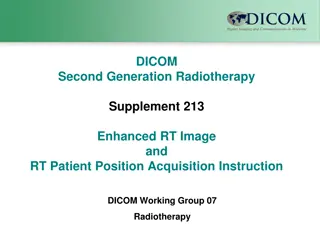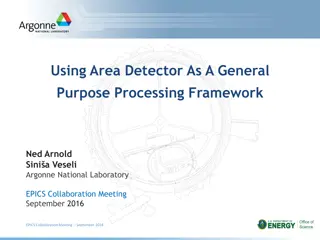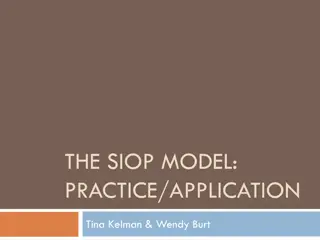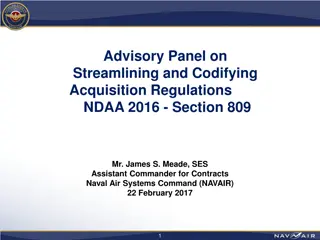Understanding Performance-Based Acquisition and its Benefits
Performance-Based Acquisition (PBA) focuses on achieving results rather than the process. It involves Performance Work Statements (PWS), which describe desired outcomes clearly. This approach enables measuring performance against standards and encourages innovation and cost-effective methods. By emphasizing measurable outcomes, contractors are incentivized to improve performance, leading to reduced contract prices, improved contractor performance, and greater flexibility to adapt to changing requirements within scope.
Download Presentation

Please find below an Image/Link to download the presentation.
The content on the website is provided AS IS for your information and personal use only. It may not be sold, licensed, or shared on other websites without obtaining consent from the author. Download presentation by click this link. If you encounter any issues during the download, it is possible that the publisher has removed the file from their server.
E N D
Presentation Transcript
Elements of a Performance Work Statement (PWS)
PERFORMANCE BASED ACQUISITION PERFORMANCE BASED ACQUISITION Performance-based acquisition (PBA) means an acquisition structured around the results to be achieved as opposed to the manner by which the work is to be performed. Performance Work Statement (PWS) means a statement of work for performance-based acquisitions that describes the required results in clear, specific and objective terms with measurable outcomes. FAR 2.101 FAR 2.101 2
PERFORMANCE WORK STATEMENT PERFORMANCE WORK STATEMENT Describes work in terms of required results rather than how the work is to be accomplished or the number of hours to be provided Enables assessment of work performance against measurable performance standards Relies on measurable performance standards and financial incentives in a competitive environment to encourage innovation and cost effective methods of performing the work 3
PERFORMANCE PERFORMANCE- -BASED METHODOLOGY METHODOLOGY BASED PROCESS PROCESS METHODOLOGY METHODOLOGY Requirements described in terms of processes or tasks Requirements described in terms of end result V V Contractor complies with commercial standards Gov t instructs contractor when, where, how, and how many Does not address desired end result Contractor provides labor mix & skill set solutions to fulfill requirements Quality assurance is labor intensive Relies on contractor quality control plan-- Trust-but validate 4
BENEFITS OF PERFORMANCE BENEFITS OF PERFORMANCE- -BASED REQUIREMENTS REQUIREMENTS BASED o Reduced contract prices o Improved contractor performance o Measurable performance requirements o Clearly defined outcomes o Leaves no question as to whether a contractor has met requirement o Contractor flexibility Contractor can change processes in response to changing requirements within scope without contract modification o Decreased surveillance Review contractor provided data/metrics Evaluate end results o Contractor innovation Incentivizes contractor to streamline processes, reducing costs 5
ELEMENTS OF PERFORMANCE ELEMENTS OF PERFORMANCE- -BASED PWS PWS BASED Requirements include clear, unambiguous, and measurable performance thresholds Surveillance methods focus on end results, not the process Requirements are outcome-based 6
DEVELOPING A PERFORMANCE DEVELOPING A PERFORMANCE- -BASED REQUIREMENT REQUIREMENT BASED Define the desired outcomes What must be accomplished to satisfy the requirement? Conduct an outcome analysis What tasks must be accomplished to arrive at the desired outcomes? Conduct performance analysis When or how will I know that the outcome has been satisfactorily achieved, and how much deviation from the performance standard will I allow the contractor, if any? 7
DEFINE THE DESIRED OUTCOMES DEFINE THE DESIRED OUTCOMES List what needs to be accomplished from a top-level perspective A description of the requirements in terms of outcomes Determine all dependent variables Requirements to be outcome- based Outcomes must be measurable 8
TREE DIAGRAM TREE DIAGRAM Office Building Floors Furniture Fixtures Appliances Walls Hardwood Linoleum Carpet Tile Metal Sinks Refrigerator Dishwasher Stove Windows Paintings Posters Surfaces Wood Systems Wall-to-Wall Shower Interior Blinds Oriental Leather Toilets Exterior Curtains Cabinets Glass 9
CONDUCT AN OUTCOME ANALYSIS CONDUCT AN OUTCOME ANALYSIS Identify specific performance objectives Ensure that each performance objective is necessary Avoid restrictive performance objectives Identify only the essential outputs 10
EXAMPLE OUTCOME ANALYSIS FOR EXAMPLE OUTCOME ANALYSIS FOR CLEANING SERVICE CLEANING SERVICE Input Input Work Work Output Output Include in Contract? Include in Contract? Furniture: Yes No Hygienically clean and conserved Clean, de-rust, and polish Metal X Hygienically clean and preserved Clean, protect, and preserve Wood Systems X Hygienically clean and conserved Leather Clean, moisturize, and protect X 11
CONDUCT A PERFORMANCE ANALYSIS CONDUCT A PERFORMANCE ANALYSIS Identify how performance objective should be measured Establish Performance Standards Identify Acceptable Quality Levels (AQLs) Example: Desired Outcomes Required Service (What task must be accomplished to give us the desired result?) Performance Standard (What do we want to accomplish as the end result of this contract?) (What should the standards for completeness, reliability, accuracy, timeliness, quality and/or cost be?) 1. X. User guides and other documentation provided are accurate, complete, and easy to use. Documentation shall meet agency requirements for accuracy, completeness, and ease of use. 95% of the documentation provided meets the stated standards. 12
DEVELOP PERFORMANCE STANDARDS DEVELOP PERFORMANCE STANDARDS Ensure the standard is needed and not unduly burdensome (Let the offerors propose them.). Components of standards are indicators (essential characteristics of acceptable performance), Use commercial standards where practicable; Must be measurable, easy to apply, and attainable. Delivery time, error rates (accuracy), operational costs, responsiveness, adherence to specifications, etc. 13
DEFINE ACCEPTABLE QUALITY DEFINE ACCEPTABLE QUALITY LEVELS LEVELS Maximum allowable deviation State the minimum standard, Must be realistic, percentage of errors allowed, cost trade-offs, etc. 14
METHODS OF SURVEILLANCE METHODS OF SURVEILLANCE Contractor Self- Reporting 100% inspection Random Sampling Periodic Inspection Client Input 15
INCENTIVES INCENTIVES FAR 37.602(b)(3), FAR 37.602(b)(3), states: Rely on the use of measurable performance standards and financial incentives in a competitive environment to encourage competitors to develop and institute innovative and cost- effective methods of performing the work. o Align incentive criteria to performance, cost, or scheduling results; o Ensure the cost benefit equation justifies the incentive; and o FAR 16.401 (d) requires a D&F to support use in the contract file. 16
INCENTIVE STRATEGIES INCENTIVE STRATEGIES o Incentives need not be limited to cost o Incentives should be based on target performance standards, not minimum contractual requirements o Avoid rewarding contractors for simply meeting contract requirements o Ensure that incentives motivate the contractor to measurable quality control processes o Use a combination of positive and negative incentives 17
INCENTIVE CONSIDERATIONS INCENTIVE CONSIDERATIONS o Will enhanced performance provide additional value to the agency? o Which areas of the requirement would benefit most from enhanced performance? o How much is the agency willing to pay to achieve a level of performance beyond the performance standard? o Do contractors within the particular industry prefer additional performance periods (award terms) in lieu of monetary incentives (award fees)? 18
PERFORMANCE REQUIREMENTS SUMMARY PERFORMANCE REQUIREMENTS SUMMARY (PRS) (PRS) PERFORMANCE THRESHOLD METHOD OF SURVEILLANCE PERFORMANCE OBJECTIVE INCENTIVES (Also indicate who performs. For example: One hundred percent inspection by the COR.) (This is the maximum error rate. For example: Zero deviation from standard.) STANDARD (If any, Positive and/or Negative Impact on Contractor Payments) (The service required; usually a shall statement) Performance requirements summary (PRS) #1 (Insert PWS paragraph.) PRS # 2 (Insert PWS paragraph number.) PRS # 3 (Insert PWS paragraph number.) PRS # 4 (Insert PWS paragraph number.) 19
PUTTING IT ALL TOGETHER PUTTING IT ALL TOGETHER INCENTIVE (POSITIVE AND/OR NEGATIVE) (IMPACT ON CONTRACTOR PAYMENTS ACCEPTABLE QUALITY LEVELS METHODS OF SURVEILLANCE REQUIRED SERVICES (TASKS) PERFORMANCE STANDARDS EXAMPLES: File reviews, periodic inspections, and random, observations, customer complaints -$500 for each documented instance when a report is submitted after the 15th of the month. 100% of reports accurately depict current status Submit a PM report of scheduled, completed, and outstanding tasks monthly (PWS C.2.1.2 (G)) 99% Administer quality control program including subcontractor management in accordance with QCP File reviews, periodic inspections, and random, observations, customer complaints Contractor is in compliance with QCP 97% of the time Submit management reports as required 95% 20
PERFORMANCE WORK STATEMENT PERFORMANCE WORK STATEMENT 1. General 2. Definitions and Acronyms 3. Government Furnished Items 4. Contractor Furnished Items 5. Description of Work (Tasks) 6. Applicable Regulations and Manuals 7. Attachment/Technical Exhibits 21
TIPS FOR WRITING THE PWS TIPS FOR WRITING THE PWS Style: Include all essential information in a concise, accurate, thorough, and logical sequence with the clearest, simplest possible presentation. Avoid complex words Sentences: Eliminate long, complicated sentences by rearranging into small sentences Jargon: Avoid legal or technical jargon. Define anything that might not be clear to anyone on the street Paragraphs: Avoid long paragraphs Ambiguity: Do not use vague, indefinite, or uncertain terms that have double meanings. You can t qualify or measure them, e.g.: Securely mounted Properly assembled. Carefully performed. 22
TIPS FOR WRITING THE PWS TIPS FOR WRITING THE PWS Numbers: Spell out numbers under 10 except for dimensions. Use the numerals numbers 10 and above. Write dimensions, temperature, percentages, and dollars and cents as numerals (2 inches, 40 degrees F, 30 percent, $10.75) Redundancy & Repetition: Avoid it. It creates a possibility of an inconsistency Punctuation: Use minimal punctuation. If complicated sentences require more punctuation, rewrite the sentence. Shorten it. Inadvertent or misplaced punctuation can change the meaning Abbreviations/Acronyms: If you have to use them, define them first 23
TIPS FOR WRITING THE PWS TIPS FOR WRITING THE PWS Symbols: Use the full word instead, e.g., pound instead of # , at instead of @ , percent instead of %. Misused Words & Phrases: Shall & Will: Shall is a binding term. Will is a suggestion of a future event. Use shall when expressing a binding requirement on the part of the contractor. Use will to refer to the Government s future actions Any & Either: Both words imply a choice. Any refers to more than two choices. Either refers to a choice between two options And & Or: Use and if BOTH conditions are true. Use or if only ONE condition is true. Don t use and/or because it shows a contradiction Etc.: Avoid using it because the reader might not know what else is available 24
TIPS FOR WRITING THE PWS TIPS FOR WRITING THE PWS Voice: Use the ACTIVE voice rather than the PASSIVE voice. The active voice is always clearer. Examples: Active: Clean up all debris at the end of each workday Passive: The debris shall be picked up at the end of each workday Active: Empty trash containers twice a week Passive: Trash containers shall be emptied twice a week Active: Install new air filters in accordance with manufacturer's recommendations Passive: New air filters are required in accordance with the manufacturer's recommendations 25
QUALITY ASSURANCE SURVEILLANCE PLAN QUALITY ASSURANCE SURVEILLANCE PLAN (QASP) (QASP) o Systematic method to evaluate the services of the contractor o Identifies the performance indicators, standards, inspections methods and procedures to be used in monitoring performance o Details thresholds for acceptable and unacceptable performance The QASP explains the following: oWhat will be monitored oHow monitoring will take place oWho will conduct the monitoring oHow monitoring efforts and results will be documented 26
SUMMARY SUMMARY Define requirements in clear, concise language identifying specific work to be accomplished Describe the work in terms of what (end result) rather than how (processes) Enable assessment of performance against measurable performance standards Use measurable standards and incentives to encourage innovation and cost- effective methods of performance Cite publications by specific paragraph/chapter, referencing only needed portions 27
ADDITIONAL REFERENCES ADDITIONAL REFERENCES FAR 37.6, Service Contracting, Performance-Based Acquisition Seven Steps to Performance-Based Services Acquisition https://www.acquisition.gov/seven_steps/home.html Performance-Work-Statement-Template http://www.easc.noaa.gov/APG/PBA/PBA_Docs/Performance-Work- Statement-Template.doc 28























